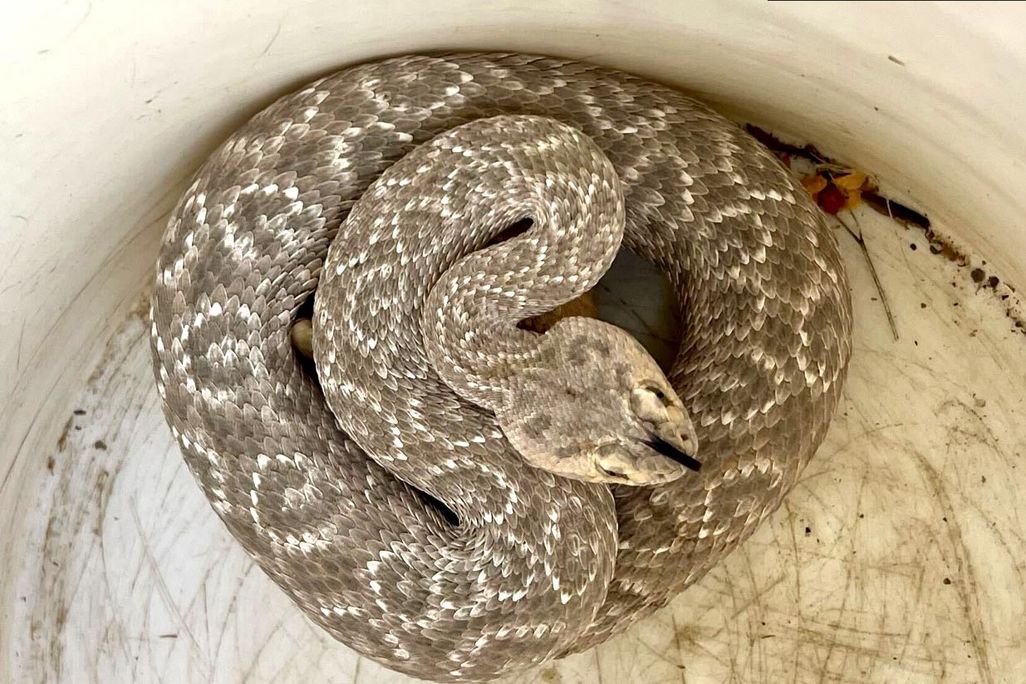This Eye-Catching Rattlesnake Found in Arizona Has Unusual 'Leopard Spots,' Likely From a Genetic Mutation
This Eye-Catching Rattlesnake Found in Arizona Has Unusual ‘Leopard Spots,’ Likely From a Genetic Mutation
Snake wranglers safely relocated the healthy, female western diamondback from a backyard in Scottsdale, but they say the find is a first in their experience
The healthy adult female was covered in curvy circles, similar to leopard spots.
Rattlesnake Solutions / Facebook
Arizonans are accustomed to seeing western diamondbacks slithering around or sunning themselves on rocks. But recently, rattlesnake wranglers came across a “weird” and “funky-looking” individual with highly unusual patterning.
Experts with Rattlesnake Solutions, a humane snake relocation and prevention company, were called in to remove a western diamondbackfrom a backyard in Scottsdale on May 9. When they arrived, they found a 30-inch-long, healthy, adult female with a “big pattern mutation,” according to a post the company shared on Facebook.
“In the many thousands of diamondbacks we’ve seen over the years, this is a first,” the company adds.
Instead of the typical, diamond-shaped pattern these snakes are named for, the female was covered in round, curvy spots. The snake’s coloring was also uncommon.
“It’s hard to tell exactly what is going on here, but it looks like the normal diamondback pattern is disrupted,” Bryan Hughes, the owner of Rattlesnake Solutions, tells McClatchy News’ Mark Price in an email. “The resulting pattern looks like circles, or ‘leopard spots’ as some have noted. It also lacks the characteristic facial stripes, has a unique pattern on the head and has peachy orange tones throughout that are atypical.”
Near the snake’s rattle at the end of its tail is a section of black and white patterning. “That’s the only normal thing about it,” Rattlesnake Solutions writes in a comment on Facebook. Western diamondbacks typically have evenly sized bands of alternating white and black close to the rattle.Based on the location, Hughes does not believe the snake is a hybrid, or the offspring of two different parent species. Instead, he suspects the odd pattern is the result of “a unique mutation in the wild,” he tells McClatchy News. If that’s the case, Hughes worries the mutation could be a symptom of “environmental stress.”
“This is a very pretty snake, but it may also be a warning,” he tells McClatchy News. “The area where this snake was found is in a zone of heavy urban development and increasing yearly temperatures. … If mutations like this are an indicator of genetic mutation in response to a warming climate, it may be something we see more of in urban areas.”
Speaking with People magazine’s Madison E. Goldberg, Hughes says he wonders whether the pattern is hereditary or if the state’s recent dry spell could have affected the snake. Arizona has been experiencing a “severe and sustained” drought since the mid- to late 1990s, according to the Arizona Department of Water Resources. More recently, the period between April 2020 and March 2025 was the third warmest and fourth driest on record.
In 2024, the Phoenix metropolitan area—which includes Scottsdale—had its hottest year ever, breaking the previous record by 1.3 degrees. The area saw 70 days with high temperatures at or above 110 degrees, compared to the typical 21 days.
Though the leopard-like pattern is extremely rare, snake aficionados do occasionally find wild serpents with mutations. Typically, however, the mutations show up as stripes or missing patterns.
“In the past 25 years, only three snakes that have a similar mutation have been seen: this one, another in the same general area in 2016 and the first found around 20 years ago,” Hughes tells People magazine. “It’s the first I’ve ever seen, and likely the last.”
After the Rattlesnake Solutions team captured the snake in the backyard in Scottsdale, they moved it to another location and released it back into the wild.
Rattlesnake season is well underway in Arizona, which is home to around 13 species—including the Arizona ridge-nosed rattlesnake, the official state reptile. Rattlesnakes tend to be most active from March through October.
Get the latest stories in your inbox every weekday.
#this #eyecatching #rattlesnake #found #arizona
This Eye-Catching Rattlesnake Found in Arizona Has Unusual 'Leopard Spots,' Likely From a Genetic Mutation
This Eye-Catching Rattlesnake Found in Arizona Has Unusual ‘Leopard Spots,’ Likely From a Genetic Mutation
Snake wranglers safely relocated the healthy, female western diamondback from a backyard in Scottsdale, but they say the find is a first in their experience
The healthy adult female was covered in curvy circles, similar to leopard spots.
Rattlesnake Solutions / Facebook
Arizonans are accustomed to seeing western diamondbacks slithering around or sunning themselves on rocks. But recently, rattlesnake wranglers came across a “weird” and “funky-looking” individual with highly unusual patterning.
Experts with Rattlesnake Solutions, a humane snake relocation and prevention company, were called in to remove a western diamondbackfrom a backyard in Scottsdale on May 9. When they arrived, they found a 30-inch-long, healthy, adult female with a “big pattern mutation,” according to a post the company shared on Facebook.
“In the many thousands of diamondbacks we’ve seen over the years, this is a first,” the company adds.
Instead of the typical, diamond-shaped pattern these snakes are named for, the female was covered in round, curvy spots. The snake’s coloring was also uncommon.
“It’s hard to tell exactly what is going on here, but it looks like the normal diamondback pattern is disrupted,” Bryan Hughes, the owner of Rattlesnake Solutions, tells McClatchy News’ Mark Price in an email. “The resulting pattern looks like circles, or ‘leopard spots’ as some have noted. It also lacks the characteristic facial stripes, has a unique pattern on the head and has peachy orange tones throughout that are atypical.”
Near the snake’s rattle at the end of its tail is a section of black and white patterning. “That’s the only normal thing about it,” Rattlesnake Solutions writes in a comment on Facebook. Western diamondbacks typically have evenly sized bands of alternating white and black close to the rattle.Based on the location, Hughes does not believe the snake is a hybrid, or the offspring of two different parent species. Instead, he suspects the odd pattern is the result of “a unique mutation in the wild,” he tells McClatchy News. If that’s the case, Hughes worries the mutation could be a symptom of “environmental stress.”
“This is a very pretty snake, but it may also be a warning,” he tells McClatchy News. “The area where this snake was found is in a zone of heavy urban development and increasing yearly temperatures. … If mutations like this are an indicator of genetic mutation in response to a warming climate, it may be something we see more of in urban areas.”
Speaking with People magazine’s Madison E. Goldberg, Hughes says he wonders whether the pattern is hereditary or if the state’s recent dry spell could have affected the snake. Arizona has been experiencing a “severe and sustained” drought since the mid- to late 1990s, according to the Arizona Department of Water Resources. More recently, the period between April 2020 and March 2025 was the third warmest and fourth driest on record.
In 2024, the Phoenix metropolitan area—which includes Scottsdale—had its hottest year ever, breaking the previous record by 1.3 degrees. The area saw 70 days with high temperatures at or above 110 degrees, compared to the typical 21 days.
Though the leopard-like pattern is extremely rare, snake aficionados do occasionally find wild serpents with mutations. Typically, however, the mutations show up as stripes or missing patterns.
“In the past 25 years, only three snakes that have a similar mutation have been seen: this one, another in the same general area in 2016 and the first found around 20 years ago,” Hughes tells People magazine. “It’s the first I’ve ever seen, and likely the last.”
After the Rattlesnake Solutions team captured the snake in the backyard in Scottsdale, they moved it to another location and released it back into the wild.
Rattlesnake season is well underway in Arizona, which is home to around 13 species—including the Arizona ridge-nosed rattlesnake, the official state reptile. Rattlesnakes tend to be most active from March through October.
Get the latest stories in your inbox every weekday.
#this #eyecatching #rattlesnake #found #arizona
·80 Vue









